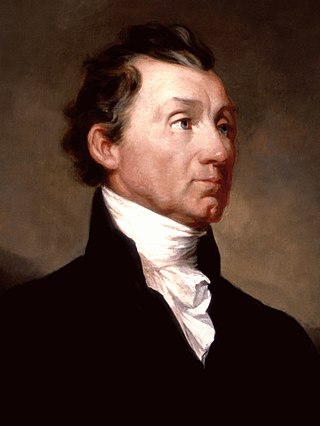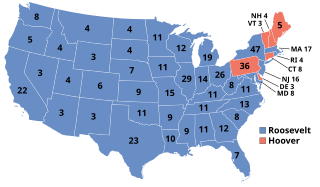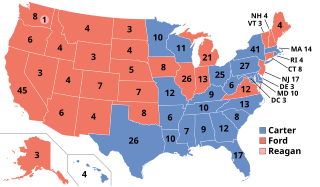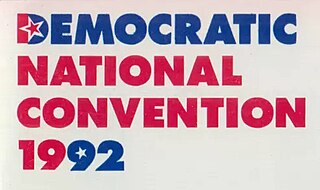
Presidential elections were held in the United States from November 1 to December 6, 1820. Taking place at the height of the Era of Good Feelings, the election saw incumbent Democratic-Republican President James Monroe win reelection without a major opponent. It was the third and the most recent United States presidential election in which a presidential candidate ran effectively unopposed. James Monroe's re-election marked the first time in U.S. history that a third consecutive president won a second election.

Presidential elections were held in the United States on November 8, 1932. Against the backdrop of the Great Depression, incumbent Republican President Herbert Hoover was defeated in a landslide by Democrat Franklin D. Roosevelt, the governor of New York and the vice presidential nominee of the 1920 presidential election. The election marked the effective end of the Fourth Party System, which had been dominated by Republicans, and it was the first time since 1916 that a Democrat was elected president.

Presidential elections were held in the United States on November 2, 1976. The Democratic ticket of former Georgia governor Jimmy Carter and Minnesota senator Walter Mondale narrowly defeated the Republican ticket of incumbent president Gerald Ford and Kansas senator Bob Dole. This was the first presidential election since 1932 in which the incumbent was defeated, as well as the only Democratic victory of the six presidential elections between 1968 and 1988 and the last time the Democratic ticket would win until 1992. Carter was the first non-incumbent politician representing a Southern state to be elected president since Zachary Taylor in 1848.

William Findlay was an American farmer, lawyer, and politician. A member of the Democratic-Republican Party, he served as the fourth governor of Pennsylvania from 1817 to 1820, and as a United States senator from 1821 to 1827. He was one of three Findlay brothers born and raised in Mercersburg, Pennsylvania, on their family farm.

Joseph Hiester was an American politician, who served as the fifth governor of Pennsylvania from 1820 to 1823. He was a member of the Hiester family political dynasty, and was a member of the Democratic-Republican Party.

The 1992 Democratic National Convention nominated Governor Bill Clinton of Arkansas for president and Senator Al Gore from Tennessee for vice president; Clinton announced Gore as his running-mate on July 9, 1992. The convention was held at Madison Square Garden in New York City, New York from July 13 to July 16, 1992. The Clinton-Gore ticket then faced and defeated their Republican opponents, President George H. W. Bush and Vice President Dan Quayle as well as the independent ticket of Ross Perot and James Stockdale in the 1992 presidential election.

The 1986 United States Senate elections were elections for the United States Senate. Held on November 4, in the middle of Ronald Reagan's second presidential term, the 34 seats of Class 3 were contested in regular elections. The Republicans had to defend an unusually large number of freshman Senate incumbents who had been elected on President Ronald Reagan's coattails in 1980. Democrats won a net of eight seats, defeating seven freshman incumbents, picking up two Republican-held open seats, and regaining control of the Senate for the first time since January 1981. This remains the most recent midterm election cycle in which the sitting president's party suffered net losses while still flipping a Senate seat.

Hiester Clymer was an American politician and white supremacist from the state of Pennsylvania. Clymer was a member of the Hiester family political dynasty and the Democratic Party. He was the nephew of William Muhlenberg Hiester and the cousin of Isaac Ellmaker Hiester. Although Clymer was born in Pennsylvania, he was adamantly opposed to Abraham Lincoln's administration and the Republican Party's prosecution of the American Civil War. Elected Pennsylvania state senator in 1860, Clymer opposed state legislation that supported the state Republican Party's war effort. After the American Civil War ended, Clymer unsuccessfully ran for the Pennsylvania Governor's office in 1866 on a white supremacist platform against Union Major-General John W. Geary. After his election to the U.S. House of Representatives in 1872 as a Democrat, Clymer would be primarily known for his investigation of Sec. William W. Belknap's War Department in 1876. Belknap escaped conviction in a Senate impeachment trial, and had resigned his cabinet position before being impeached by the House of Representatives. Having retired from the House in 1881, Clymer served as Vice President of the Union Trust Co. of Philadelphia and president of the Clymer Iron Co. until his death in 1884.

The 1964 United States Senate elections were held on November 3. The 33 seats of Class 1 were contested in regular elections. Special elections were also held to fill vacancies. They coincided with the election of President Lyndon B. Johnson by an overwhelming majority, to a full term. His Democratic Party picked up a net two seats from the Republicans. As of 2023, this was the last time either party has had a two-thirds majority in the Senate, which allowed the Senate Democrats to override a veto, propose constitutional amendments, or convict and expel certain officials without any votes from Senate Republicans. However, internal divisions would have prevented the Democrats from having done so. The Senate election cycle coincided with Democratic gains in the House in the same year.

The 1944 United States Senate elections coincided with the re-election of Franklin D. Roosevelt to his fourth term as president. The 32 seats of Class 3 were contested in regular elections, and three special elections were held to fill vacancies.

The 1998 Pennsylvania gubernatorial election was held on November 3, 1998. The candidates were incumbent Republican Tom Ridge, Democrat Ivan Itkin, Constitutionalist Peg Luksik and Libertarian Ken Krawchuk. Ridge, a popular moderate, won with 57 percent of the votes cast.

The 1970 Pennsylvania gubernatorial election was held on November 3. Democrat Milton Shapp challenged incumbent Republican Lieutenant Governor Ray Broderick.

The 1980 United States Senate election in Pennsylvania was held on November 4, 1980. Incumbent Republican U.S. Senator Richard Schweiker decided to retire, instead of seeking a third term.

Elections to the House of Representatives were held in Pennsylvania on October 14, 1794, for the Fourth Congress.

The 1823 Pennsylvania gubernatorial election occurred on October 14, 1823. Incumbent Federalist governor, Joseph Hiester, did not seek re-election. The Democratic candidate, John Andrew Shulze, defeated Federalist candidate Andrew Gregg.

The 1817 Pennsylvania gubernatorial election occurred on October 14, 1817. Incumbent Democratic-Republican governor Simon Snyder was not a candidate for re-election. Simon's preferred successor, State Treasurer William Findlay, was nominated as the Democratic Republican candidate by a caucus of legislative leaders. Conversely, U.S. Representative Joseph Hiester was chosen as a candidate by the Democratic Republicans' first popular nominating convention; he additionally gained the endorsement of the declining Federalists.

The 1820–1821 United States Senate election in Pennsylvania was held on three separate dates from December 1820 to December 1821. On December 10, 1821, William Findlay was elected by the Pennsylvania General Assembly to the United States Senate.
Governor Milton Shapp of Pennsylvania unsuccessfully sought the Democratic Party nomination for president of the United States in the 1976 election. Shapp won reelection as governor of Pennsylvania in the 1974 election, the first Pennsylvania governor to be elected to a second four-year term following an amendment permitting this in 1967, and had hoped to translate his relative popularity in Pennsylvania into the groundwork of a successful presidential campaign.

The 1866 Pennsylvania gubernatorial election occurred on October 9, 1866. Incumbent governor Andrew Gregg Curtin, a Republican, was not running for re-election.





















